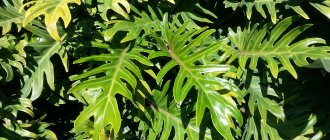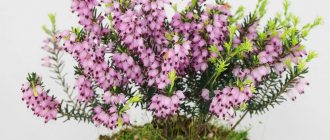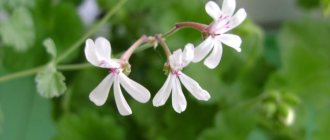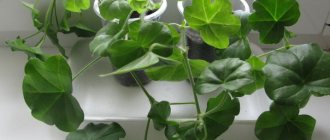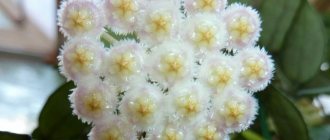There are some plants that immediately attract attention. In any flower arrangements, they have a solo part prepared in advance. Schefflera is exactly such a plant. Her strength lies not only in her striking beauty, but also in her special energy..
It absorbs negativity from the environment, helps you relax and unwind. It also purifies the air. An unpretentious plant is a welcome guest in any home . But what is this flower and how does it reproduce at home?
general information
The most characteristic feature of Schefflera (pictured) is its unusual leaves. They have a finger-complex structure. Each leaf consists of several lobes.
They can be oval or pointed. Externally they resemble fingers . Each slice meets the others in the center. The presence of thin petioles makes the leaf look like a smaller copy of an umbrella.
The height of shefflera in its natural environment reaches from 4 to 6 m, and the lush crown in volume reaches 1.5 m. A miracle of nature is budding . Paniculate peduncles are painted in various shades. Later, berries appear in their place. Seeds are obtained from them. In indoor conditions, the formation of flowers is a very rare occurrence.
Growing from seeds
When propagating cheflera by seed, the seeds need to be kept in a solution of Zircon or Epin. We put drainage at the bottom of the pot, then a mixture of sand and peat. We plant the seeds to a depth of 15 centimeters, cover the pot with film and care for them as if we were rooted cuttings: water, ventilate, spray. You can transplant the sheflera sprouts into a separate pot when leaves appear on them.
It is curious that different types of Schefflera take root in different ways. Variegated varieties take much longer to produce roots than green varieties. Green varieties can be grown by rooting a leaf.
Schefflera: description and origin, photo
This beauty represents the Araliev family. The most popular varieties are wood shefflera. Its habitat is tropical forests in Southeast Asia.
These plants are also very common in Indonesia and the Malay Archipelago . There are about 200 species of Schefflera in the wild, but there are no more than a dozen ornamental species.
Four types are best suited for indoor floriculture:
- Palmate. The oval-shaped leaves consist of 7–10 elongated “fingers” with long petioles. There are bright veins. The bush itself is quite compact.
- Radifolia. This species is also called star-shaped. It is distinguished by large leaves (about 15 cm long). They have a rich green tint.
- Tree-like. Its characteristic feature is the complex structure of the leaves. They are glossy and quite dense. The bush reaches 1.2 meters in length. There are both green and variegated varieties.
- Eight-leaved. A very rare species. But it has already gained popularity among flower growers. The leaf length reaches 30 cm, and the width is about 10 cm. The surface is decorated with light veins.
This video shows some types of Schefflera and gives recommendations for caring for the plant.
We analyze the results and choose the best method of propagating sheflera
In the soil, the shefflera produced strong roots a week earlier than in water, so the next time when propagating the shefflera, I will immediately plant the cuttings in a tall, narrow pot or glass, and will not root in water.
Regarding rooting using air outlets, I can say that this method is worth considering if you need to trim the plant and root a large top with a woody trunk. However, my experiment showed that in order to force more roots, it is worth stripping a longer section (at least 4 cm) in order to capture several growth points. The ability to use air outlets can also be useful with other indoor and garden plants; I wrote about my experience with Ficus Benjamin here.
Schefflera: propagation at home
Like many other plants, Schefflera can be propagated by two methods: vegetative and generative.
Seeds
Planting material can be easily purchased at the store. It is almost impossible to obtain seeds yourself . They are planted in January or February. By the arrival of calendar spring, the plant obtained from seeds will have time to grow stronger and adapt to environmental conditions.
Advice! They are first kept in warm water or epin solution (no longer than a day). Then they take wide containers with high walls and fill them with fertile and light soil. Boxes are quite suitable for these purposes. The seeds are buried approximately 5 mm.
After this, the soil is moistened and the containers are sealed with film. Having an improvised greenhouse is mandatory .
Caring for seedlings is simple. It is enough to put them in a bright place, regularly ventilate them and spray them with warm water from a small spray bottle. Sprouts with a pair of clear leaves can be picked.
Instructions for propagation by cuttings
Cuttings are carried out most often. There are two ways to achieve the appearance of roots on the stems: by placing them in a container with water or directly in the soil.
Cuttings in water
For this method it is better to use root cuttings . A transparent jar or any other container is filled with water. Then the plant is placed.
Note! To prevent rotting, it is useful to add charcoal or activated carbon; root can also be used.
The cutting that has already begun to become lignified and has several rosettes of leaves will take root faster. You will have to wait about three weeks . When the roots grow a couple of centimeters, you can transplant the schefflera into the ground.
Rooting cuttings with leaves in the ground
They are harvested in the spring or at the very beginning of summer. The optimal length of the cutting is from 5 to 10 cm. Before taking the shoot, the instrument must be disinfected. The cut site must be treated with special preparations . You can choose from succinic acid, heteroauxin or root.
Advice! The best substrate for rooting is nutritious soil or wet sand. Drainage is very important. Pots with cuttings are covered with a cap made of a regular plastic bag.
Now it is necessary to ensure a constant temperature within + 21–24 degrees. Periodically, the plant requires access to fresh air.
Leaf propagation technology
It can be difficult to achieve a positive result when rooting by leaf. It doesn't always take root . A medium-sized plate must be carefully separated from an adult plant along with the growth zone. It is a growth located between the base of the leaf and the stem.
Add growth stimulants to the settled water and place planting material in them. It's better to take several. Now the vessel needs to be wrapped in film and left warm.
Important! With the appearance of roots, it is time to move the leaf into a preheated substrate. Maintain greenhouse conditions. After a while, begin to ventilate the plantings and introduce moisture into the ground.
Air layering
Propagation of shefflera from an adult flower is the simplest. The mother plant must be mature and absolutely healthy. A cut is made on the non-main stem . They wrap it around it successively with moss, cotton wool and film.
Layers of moss and cotton wool are regularly moistened. The process of roots appearing will take approximately 1.5 months. The resulting air layering must be separated along with the stem. Next they are placed in a pot with suitable soil .
This video shows how to propagate Schefflera from cuttings.
Possible problems
What problems might novice gardeners have in the process of propagating and growing cheflera? There are many of them, and each has its own characteristics. Surgical intervention will prevent the development and growth of the flower from slowing down, and will also reduce the chances of it wilting.
Falling leaves
It is important to understand the reason why Schefflera leaves fall. As a rule, this indicates that moisture standards have not been met. To stop this problem, you should protect the flower from liquid for a while and place it in a more illuminated place.
Falling and darkening of foliage
Withering and dying of foliage can occur due to incessant drafts or gusts of cold wind. During ventilation, it is necessary to ensure that the plant is reliably protected from drafts and cold air. With severe hypothermia, the plant may even die.
Blackening of leaves
Typically, the leaves acquire a darker color or turn completely black if the plant is damaged by pests. Such troubles are caused by parasites such as thrips, spider mites and scale insects. You can get rid of them using ready-made commercial insecticides. To remove pests, it will be enough to spray the flowers with them. If there are very few parasites, then the plant can be sprayed with a solution of laundry soap.
So, the Schefflera flower brings prosperity and peace to the house, so it should be protected from harmful factors and, if possible, propagated. And, following the tips and recommendations described in this article, even an inexperienced gardener can propagate sheflera at home without any problems. The main thing is to find for yourself the optimal method that corresponds to the level of practical skills, as well as a specific type of flower suitable for propagation.
General rules of care
The plant will need intense indirect light. On summer days, the flower is taken outside , shading it from the scorching sun. For decorative species, proper lighting plays a special role.
Important! In winter, shefflera is kept at +13–16 degrees (but not lower than +12), and in summer a temperature of +18 to +22 degrees is considered normal. If it rises higher, growth slows down.
The plant is contraindicated in the proximity of heating devices, air conditioners, as well as drafts. It is necessary to maintain high air humidity by spraying. Fertilizers begin to be applied in the spring and are done until the last days of July (approximately every 2-4 weeks).
Trimming Features
Primrose propagation: basic methods and examples at home
Schefflera grows very quickly, so it needs regular pruning. If you do not do this, the plant will grow to the ceiling. This procedure not only gives the plant its shape, but also protects it from pests.
If pruning is done correctly, new branches will soon appear on the plant.
There are two types of pruning:
- crown formation;
- removing weak and yellow leaves.
For lush branching and a thick crown of the tree, it is necessary to cut off the top. It is advisable to prune in the spring, as soon as the plant wakes up after winter hibernation.
Trimming serves several functions:
- Gives the flower the desired shape.
- Has a beneficial effect on the growth of new branches and leaves.
- Serves as a source of planting material.
- Removes weak and diseased branches.
Important! When a bush loses all its leaves, it can be saved by low pruning.
Choosing a pot
When transplanting, a new container should be taken a couple of centimeters larger than the previous one. In the case of adult specimens - by 5–6 cm. It is better if the pot is in the shape of a trapezoid or tulip . You can place several plants in one container.
Plant such a flower in your apartment, and it will not only decorate any interior, but will also become a kind of talisman for its owner: it will help open new horizons and bring good luck.
This video shows how to properly transplant Schefflera.
Transfer rules
For the first 3-4 years, shefflers are replanted annually in the spring. Adult plants need to increase the volume of the pot every 2-3 years. Large plants (1 m or more in height) are difficult to replant, so they limit themselves to partial replacement of the soil. Care for transplanted plants as usual.
Transplantation of cuttings is carried out according to the rules:
- Take the first pot of small volume (150-200 ml), preferably transparent, in order to control the development of the root system.
- When the earthen lump is completely entwined with roots, the young sheflera is transferred to a larger container, increasing the volume by no more than 150 ml.
- If the pot is too large, the growth of the flower will stop until the roots have mastered the soil. In total, in the first year 2-3, or less often 4, transplants of a young plant are done.
Interesting! Some peoples believe that sheflera is capable of predicting unpleasant events. Thus, the unexpected shedding of foliage by a healthy flower foreshadows a serious illness, or even the death of a loved one, or financial difficulties. Leaves twisted into a tube warn of approaching family conflicts.
Pests
Schefflera is attacked by pests of indoor plants such as spider mites, thrips and scale insects. Spider mites are noticeable by a white coating on the leaves and internodes, similar to small cobwebs. The scale leaves a sticky coating, and the insects themselves can be seen in the form of small brown tubercles on the leaves. Thrips can be detected by black dots on the back of the leaf blade.
Spider mite Thrips
Shchitovka
If the number of pests is small, you can use traditional methods:
- wash the leaves with soapy water;
- soak a cotton swab in alcohol and wipe the leaves where insects are found.
If these methods do not lead to the destruction of pests, then it is necessary to treat the plants with insecticides such as Aktara. After a week and a half, the treatment should be repeated.
Schefflera flower: signs
Schefflera is a plant that not all indoor plant lovers want to grow at home. Many believe that it is an energy vampire, interfering with the positive aura in the house. But esotericists and knowledgeable people claim that the flower only absorbs negativity, cleansing the house. It is recommended to install pots with plants in the bedroom. During sleep, a person's thoughts will be cleared and negativity will be absorbed. This will allow you to have a good rest and sleep. It is recommended to install the pot with the culture in the room of a schoolchild or student. This will improve your memory, and the learning process will be much faster and more successful.
Schefflera flower, signs:
- Sheflera can warn its owners about impending misfortune or unpleasant events. If the leaves curl, this indicates deception of someone close to you.
- If the leaves suddenly darken, the flower cannot cope with the negativity that is present in the house. Talk to your loved ones, try to resolve all problems without scandals. Don’t hide important information, don’t try to solve problems yourself, this will lead you to a dead end.
- If the plant has stopped producing new shoots and green leaves, financial stagnation or depression awaits you.
- It is a good sign if the crop grows quickly and produces a lush crown and a large number of green leaves. Esotericists are sure that this promises an increase in the family, perhaps the couple will have a child. They recommend installing in offices, caring for, fertilizing and watering. If the crop pleases with a large number of green leaves, this promises success and financial well-being. In the reception area of an enterprise, the plant is capable of absorbing negativity and protecting the office from ill-wishers.
Bonsai
By layering
This propagation method is usually used for large varieties of sheflera. The method gives good results, however, it requires experience, skill and accuracy from the grower.
Procedure
- In the spring, cheflers make an incision on the shoot closer to the base, then covering it with damp sphagnum.
- The incision is secured with adhesive tape, tape, or other flexible fastener. It is recommended to wrap the moss with film on top to create warm and humid greenhouse conditions inside.
- Moisten the moss regularly, preventing it from drying out. After a month, if all conditions are met, roots will appear on the cut.
- The shoot is then cut off slightly below the formed roots and transplanted into a nutrient substrate. Watch a video about rooting sheflera by layering.
